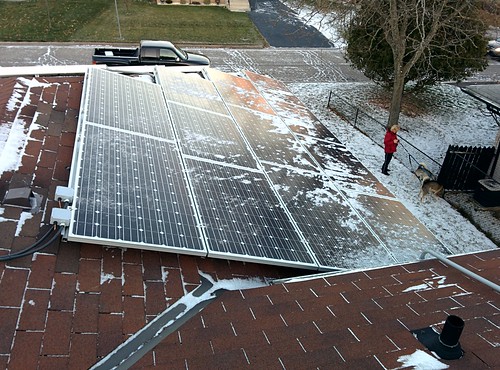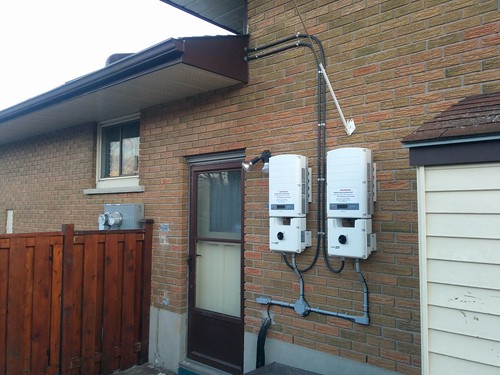
Longtime readers of this blog will remember Blackberry Ry. Ryan was a staunch defender of all things Blackberry and was even nice enough to lend me a Blackberry Playbook.
Ryan's no longer with Blackberry and is now working with the sun. I'll let him explain further in this guest blog entry he wrote.
I am solar (And so can you!) – Solar power in Ontario
I’m Ryan - that guy who used to work for BlackBerry. I work in the solar industry now.
Mike asked me to write up a guest post – with Saturday being the winter solstice (the shortest day in the year) it's probably a bad day to talk about solar... but it’s always a good day to talk about clean green energy.
There are a lot of questions about solar and a few myths… I just wanted to share my newly minted solar installation as well as answer some common questions.

So these are solar panels. They convert radiation from the sun into DC power…the same type of power that starts your car or powers your cell phone.

These are inverters. They take the DC power and turn it into AC power – the same type of power that comes out your wall sockets. This power is then sent into the electricity grid.
One of the most common questions I get about the system is – Do you have a hydro bill anymore? Yes, I still have a standard hydro bill. My installation went in under the Ontario Power Authority’s microFIT program… FIT meaning Feed-In-Tariff. Under this program, my home is essentially a very small power plant. I produce and sell electricity to my Local Electric Company at a fixed rate for 20 years. I have 2 electric meters on the side of my house – one for the solar generation and one for the power my home uses.
There are 2 other ways to put solar on your home – net metering and off-grid.
Off grid as some would know is where you are disconnected completely from the utility and use a system of batteries, solar panels, various controllers and even a propane generator for those cloudy days.
Net metering is where your electric meter would run forwards and backwards – forwards when the sun is down and backwards when the sun is up. This is the system where you offset or eliminate your hydro bill.
The controversy in solar started with the introduction of the Green Energy Act and the original rate that was set.
The original rate for the microFIT program was 80.2c/kWh – which at the time was about 10 times higher than you and I were paying for power. At that time a solar installation cost about $60,000 to $80,000. The rate was reflective of the cost of a solar installation plus giving a decent return on the buyer’s investment. This has changed and so have the rates. Now a solar installation will cost about $30,000 for the same size installation – less than ½ price of the original installation. Accordingly, the feed-in-tariff rate has dropped. New contracts received a rate of 39.6c/kWh – about 3 times what we all pay. Larger projects (anything which is greater than 10kW) receive an even lower rate.
So now that we're past the controversy (I can't wait to see the comments!)… let’s talk about the benefits of putting solar on your roof – for you and for Ontario.
Obviously, it’s a good feeling producing green energy. Making some money is nice as well – we have customers that have used solar as an RRSP plan or RESP plan! There are so many benefits outside of this.
Solar is a peaking power – that means when energy usage is highest, Solar is outputting at its highest.
This helps level off the price of electricity during the day – especially in the summer(and if you want to confirm that, just ask the IESO). Another benefit of solar power is how it benefits the electricity grid. In areas which are far away from a big generation plant – like Bruce Power or Niagara Falls – solar power can postpone upgrades to the transmission lines which saves money that us taxpayers would otherwise have to spend.
Solar power is one of the cleanest energies we have – this is something we can all agree on. When a solar plant explodes or experiences a catastrophe, you just have a bunch of glass, silicon, plastic, metals and wire to clean up. When you have catastrophes at some of the other energy producers you have long term real consequences to face. I’m not saying that solar should be the exclusive energy producer anywhere in the world – this is not practical. I just want to pass some knowledge to the great people who read this blog.
I look forward to your comments!






